
Bevin Boys and my experiences as one
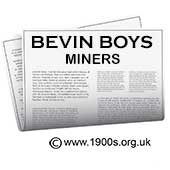
Bevin Boys were young British men conscripted to work in coal mines instead of the armed forces in the Second World War. They were named after Ernest Bevin, a member of the Labour Party, whose idea it was, and who was Minister of Labour and National Service in the Coalition Government of Winston Churchill. This page describes how Bevin Boys were selected and trained, their accommodation on the job, their pay and their leisure time – all with the emotions of firsthand experience. Their recognition after the war is included.
____
As told to the webmaster by Peter Dickens, former Bevin Boy miner
Why were Bevin Boys needed?
At the beginning of the Second Word War, mining was not a reserved occupation, so young miners were conscripted into the armed forces, just as young men in other occupations were conscripted. Also some young miners volunteered for the armed forces - possibly for reasons of patriotism or perhaps with a desire to leave the mines. Many of these young miners had been employed on essential work at the coalface. They were, at first, replaced by older and semi-retired miners. However, the work was hard, and some of the older men found it difficult to work for a full week. So there became a shortage of miners and hence a shortage of coal at a time when the need for it was increasing due to the war industries.
To compensate, Ernest Bevin announced that all men being called up for their WW2 National Service could opt to serve in coal mines instead of the armed forces. Not surprisingly the response was inadequate.
The inadequate response led to young men who might otherwise be conscripted into the forces being instead conscripted (i.e. compulsorily placed) in the mines. These young men were known as Bevin Boys.
How were Bevin Boys selected?
Towards the end of 1943 it was decreed that 10% of every call-up batch of young men would serve as miners. The selection of which 10% was made on the basis of the National Service number which every new recruit was given at enrolment. A digit between 0 and 9 was arbitrarily chosen for each batch of intakes, and everyone whose National Service number ended with 9 was directed to become a Bevin Boy and sent to a coal mining area for training.
National Service numbers were kept throughout the period of national service. So it was decreed that Bevin Boys would be released from the mines at the same time as the release of the men in their enrolment batch who had served in the armed forces. Not that this necessarily happened - read on ...
My experience of becoming a Bevin Boy
Some years before my conscription, I had joined the local branch of the Air Cadet Corps, which the government formed with the purpose of giving training which would help when joining the RAF. Accordingly I had thought that I would be called into the RAF when I attained my call-up age. I even attended a pre-joining RAF medical some weeks before the due date. A few weeks later, though, I received a letter which stated that the last digit of my National Service number matched the one picked for the coal mines. Enclosed was a railway warrant to Stoke on Trent, where I was to be given accommodation and training before attachment to a mine in the North Staffordshire coalfield, 150 miles away from where I lived.
My date of call-up was 7th February 1944, my eighteenth birthday.
Harassment in the streets: why are you not in uniform?
Churchill mentions one of his books 'The Second World War' that some Bevin Boys were harassed by people asking why they were not in uniform (ie in the Army) - a bit like the white feathers in the first war. Churchill suggested they be given a distinctive armband, to identify them as in a war-related role. I don't think it was ever implemented, though.
David R Brooks
How it felt to be conscripted to work in a mine
I have often been asked this question.
Becoming a miner was certainly not what I and most of my colleagues wanted, but there was no alternative open to us and the work had to be done. Therefore we accepted the situation and knuckled down to it. My parents were more concerned than I was.
Many of us had reservations of course, not knowing whether claustrophobia would be a problem, but fortunately it did not prove to be a worry for me. Two of my intake, though, did get exemption on the grounds of claustrophobia. They immediately volunteered to be commandos.
The work itself, its staffing and orgaanisation is described on the page about WW2 coal mines in the 1940s and 50s.
Bevin Boys' training
The training lasted for six weeks and was divided into two parts.
The first part lasted four weeks and consisted of alternate days in a lecture room and underground in an old pit which was no longer in production. We were given instruction on the working and layout of pits (mines), the safety procedures and general advice on how to behave. In both the lecture room and underground we were instructed by experienced old colliers (coal miners).
The second part of the training which lasted two weeks consisted of instruction in haulage work above ground.
Accommodation and living facilities
At the outset, I stayed with another Bevin Boy in lodgings run by a landlady. I had a bedroom, the use of a bathroom and toilet and reception rooms.
After I started working on the night shift, though, this was not practicable and I moved to another lodging where I was alone.
The landladies washed my clothes twice weekly and provided clean sheets each week, not that my clothes and bedclothes were especially dirty. Although coal did get under my skin, due to knocking my knuckles etc., my body was always clean after the daily bath.
The landladies also provided my breakfasts and evening meals plus mid-day meals at weekends. These were normal wartime fare, dependant on rations, and were usually adequate, although not ideal.
The contents of my lunch box was a sandwich, normally meat, collected before going down the pit. I can't remember who paid.
Travelling to and from the mine
I went to work in casual clothes, and according to the weather either walked or went by bus to the baths which were almost two miles from my lodgings. There I changed into work clothes and left my travelling clothes in a locker. We miners and Bevin Boys were then taken by covered lorry to the pithead.
There was no clocking in. Our lamps had to be collected before a fixed time and if we were late we could not go down the pit and hence got no pay.
At the end of the shift the whole process was reversed except that the journey from the baths to my lodgings was almost always by bus.
Pay
When I became a Bevin Boy in 1944 my pay was £5 per week. I was provided with a pair of boots with steel toe caps and a safety helmet but no other clothing. Other necessities such as lodgings, kneepads, water bottle, 'snapping tin' (lunch box) I had to pay for myself.
Leisure and free time
I had always been a sporty type and had played many ball games in and out of school. Accordingly I took any chance to get involved in any opportunities to play cricket or football, though these were fairly rare. I was able to watch both games throughout their playing seasons, though, and I also went to the cinema and generally socialised.
Recognition after the war
Note from the webmaster
During my several interviews with Peter Dickens, he never mentioned the widespread dissatisfaction felt by Bevin Boys at their treatment a the end of the war, and at that time I did not know to ask him. What I now know from others is as follows:
-
Although WW2 ended in 1945, Bevin Boys were not finally discharged from their work in the mines until 1948. Perhaps this was understandable as there was still a shortage of coal and many of the career miners were still waiting to be repatriated back to the UK.
-
Unlike other servicemen, Bevin Boys were not given a free set of civilian clothes on discharge - see the demob suit. This seems particularly harsh since their work in their own clothes had been excessively rough and dirty.
-
Unlike other demobilised servicemen, they received no war service medal. Nor did they have the right to return to the jobs they had previously held - although perhaps, this too was understandable as few would have moved far up the career ladder when conscripted. Perhaps, more positively, they were entitled to participate in the Government's Further Education and Training Scheme which paid university fees and an annual means-tested grant of up to £426 to cover living expenses whilst studying.
The Bevin Boys Veterans Badge
The lack of recognition was formally, but belatedly, addressed as late as 2008 with the Bevin Boys veterans badge.
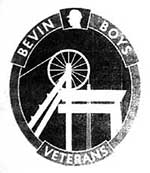
Photocopy of the Bevin Boys Veterans Badge
The veterans badge was:
'Presented with the Compliments of the Minister of State for Energy
'in recognition of your valuable
contribution to the war effort'
The Bevin Boys Association
Before the award of the medal, in 1989, interested individuals formed the Bevin Boys Association. It started in the Midlands area with just 32 members, but according to Wikipedia the membership grew to over 1,800 by 2009 with membership from all over the UK and overseas.
Peter Dickens joined the Association and supplied the following photographs.
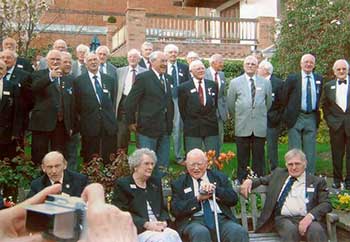
At the Bevin Boys Association Dinner, 2008. Peter Dickens is centre, back row.
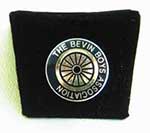
Lapel badge of the Bevin Boys Association
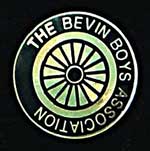
Detail of the badge
Reflections on having been a Bevin Boy
By the time that my period as a Bevin Boy had come to an end, which was after 3 years and 8 months, the nature of the work had given me an awareness of the need to be able to improvise, and this has proved of great advantage in many spheres in what are, as I write today in 2014, the 67 subsequent years.
It was an interesting experience. Although it was not what I had wanted to do, I was privileged to meet and work with experienced miners in a completely new environment. The camaraderie was wonderful, and it is difficult to imagine better support being available in any group.
If you can add anything to this page or provide a photo, I would be pleased if you would contact me.
sources: early 20th century material
sources: ww2 home front and other material
contact
the webmaster/author/researcher/editor
privacy policy
















